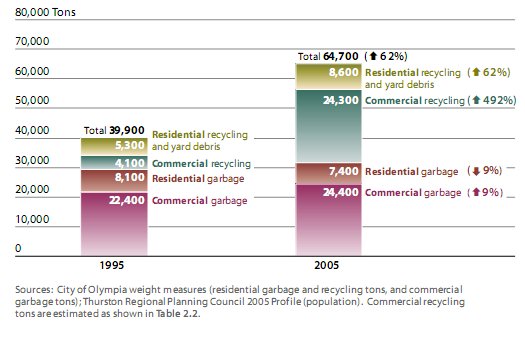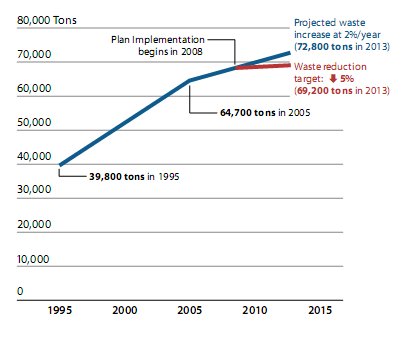Olympia, WA Zero Waste Master Plan
Type: Policy
Status: Adopted on 11/26/07
Source File: http://www.ci.olympia.wa.us/cityutilities/garbage/wastereduction/Masterplan.htm
Description:
The entire plan is spread amongst 20 separate pdf files. Shown below is a portion of the summary only. To access the entire document, refer to the source file.
In June 2006 Olympia City Council adopted a Zero Waste Resolution. It establishes a vision for the City and a new direction for the Waste ReSources Utility and gave rise to a new strategic and operational six-year plan. It adds specificity to Olympia’s Sustainable Community vision, and aligns with the Public Works vision of “Balance and Harmony between People and Nature.” In this context, the Waste ReSources mission is:
“To lead and inspire our community toward a waste-free future.”
Its strategic role is:
“To create opportunities to eliminate waste.”
For the past two decades, Olympia has been moving in this direction by providing waste reduction and recycling collection services. This Plan creates the framework for a more focused approach toward Zero Waste, with these long-term goals:
Goal 1: Reduce the overall waste generated in Olympia (garbage and recyclables). The quantity of products and materials used and ultimately discarded by Olympia residents and businesses is steadily decreasing over time.
Goal 2: Increase the quantity of recyclable and compostable materials diverted from the landfill. The percentage of discarded products and materials that are reused, recycled or composted by Olympia residents and businesses is steadily increasing over time.
Goal 3: Manage Olympia’s waste system responsibly. Discarded materials are collected, processed and disposed of reliably, with minimal impact on environmental and public health and worker safety.
THE ZERO WASTE CHALLENGE
Globally, waste is a huge problem caused by:
- A growing population.
- Increasing consumption.
- A system of resource extraction, manufacturing and distribution that encourages depletion and doesn’t factor environmental and social costs into the price of the end product.
The result is increasing depletion of natural resources and increasing greenhouse gas emissions and air and water pollution – all of which is environmentally unsustainable and costly to society as a whole. Olympia residents and businesses contribute to this global problem. Locally, a growing population and increasing quantities of waste are creating environmental problems and pressuring an already strained regional waste management system.
The movement towards Zero Waste is part of a solution because it:
- Considers the whole life cycle of a product and ways to reduce waste in “upstream” production and distribution processes as well as in “downstream” consumer choices and waste management practices.
- Supports operational efficiency by reducing the overall amount of waste to be handled, and by facilitating shared public and private responsibility for “end of life” waste management.
Toward Zero Waste: Olympia’s Waste ReSources Plan anticipates a future in which “waste” is viewed as an inefficient use of resources. It launches a long-term, systematic effort to:
- Reduce per capita quantity of waste generated in Olympia.
- Increase the portion of waste that is recycled or composted.
See Chapter 1 for details.
OLYMPIA’S PEOPLE AND THEIR WASTE
In 2005 Olympia’s residents and businesses generated approximately 64,700 tons of
waste, of which an estimated 51 percent (32,900 tons) was composted or recycled. Of
the total waste, about three quarters is generated by commercial businesses and about
one quarter by residential customers. Nearly 28 percent of the garbage sent to the landfill
is currently or potentially recyclable – particularly paper, food debris and construction
and demolition (C&D) debris. Between 1995 and 2005, total waste increased by
62 percent, as shown below.
Waste generation closely follows fluctuations in population. This Plan assumes that if Olympia’s population increases at about 2 percent per year, waste generation would increase at the same rate, totaling 72,800 tons by 2012 without implementation of the planned strategies.
See Chapter 2 for details.
CHALLENGES AND OPPORTUNITIES
Below are some of the key challenges and opportunities Olympia faces in moving toward
Zero Waste:
- Increasing population will drive an increase in waste generation, the number of customers Waste ReSources will need to serve, and the challenge of preventing waste in the first place.
- Growth in the commercial sector will increase waste generation and increase the need for effective recycling programs that serve all businesses.
- Large quantities of currently and potentially recyclable materials in the garbage – particularly paper, food debris and C&D debris – could be diverted from the landfill.
- Olympia is one of a handful of Washington cities that performs collection services with its own equipment and staff.
- The City has exclusive authority over collection and transportation of all garbage and residential recycled materials.
- Commercial recycling collection and transportation is not regulated and is subject to open market forces.
- A food debris curbside collection service has become more feasible with the opening of a state-of-the-art, appropriately permitted composting facility in Thurston County.
- The idea of “being green” is gaining momentum in the construction industry and with policy makers.
- The link between waste and climate change is becoming more obvious.
See Chapters 3-5 for details.
2008-2013: MOVING TOWARD ZERO WASTE
The intent of this Plan is to “think outside the garbage can.” It asks not what can be done
under current circumstances, with current systems and constraints, but what needs to be
done and with what resources.
Meeting the challenge of Zero Waste will require a sustained effort for the foreseeable future. During the next six years, Waste ReSources is recommending two specific targets for waste reduction and recycling:
- Reduce per capita waste by 5 percent. At current projections, by 2013
Olympia would be generating 72,800 tons of waste (garbage, recycling and organics). The waste reduction strategy aims to reduce this total by 5 percent, or approximately 3,600 tons, as shown below.
- Increase the recycling and composting portion of total waste from 51 percent to 65 percent by a combination of increased recycling of residential and commercial waste, increased diversion of organics (yard debris, food debris, and compostable paper), and improved recycling of C&D debris. If successfully implemented during the next six years, these strategies could result in diverting an additional 9,750 tons of waste from the landfill, as shown on the following page.
The goals, strategies and potential impacts if these strategies are successfully implemented are summarized on the following page. The planned actions for each strategy are described in Chapters 7-9 and summarized in Appendix 5.
Major new services in this Plan include:
- Better waste reduction and recycling education for all customers.
- Technical assistance for commercial customers, and owners/managers of mixed-use buildings and multi-family complexes.
- Better recycling opportunities in public spaces.
- An organics collection program, first for residential customers, and then for commercial customers.
Behind the scenes, Waste ReSources will continue to work on modernizing its collection and billing systems, as well as participating in county and statewide product stewardship efforts.


